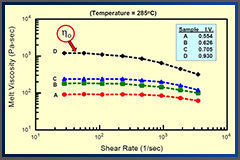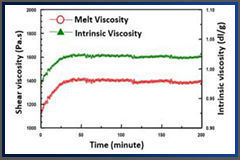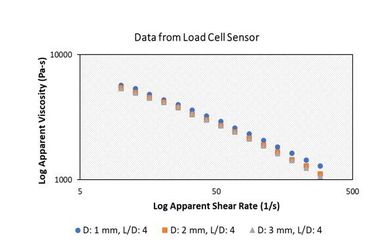It can be very difficult, if not impossible, to achieve complete identification of most polymer products. However, in most cases, this is usually not needed; what is needed is the separation, or identification, of numerous molding materials whose identity has been lost, or an indication of the type of material used to create a component. In such cases, it is justified to use simple tests
We offer more than just product delivery...
Our task is not only to deliver a high-quality product, but also to help by sharing our knowledge and experience with you. By doing so, we save you time and money, and enable you to focus on other important aspects of your business.
Correlation of Melt Viscosity of Polyethylene Terephthalate to Solution Intrinsic Viscosity
Correlation of melt viscosity of polyethylene terephthalate to solution intrinsic viscosity
Polyethylene terephthalate (PET) is a hygroscopic resin from the polyester family which absorbs moisture onto their molecular structure when they are exposed to the ambient air. This has a huge effect on the flow behavior and rheological parameters of the plastic melt. Normally, the moisture acts as a plasticizer and increases the flowability of the plastic melt. As a result, the melt flow rate (MFR) parameters of PET resins are strongly affected by their moisture level/drying condition and rarely provided by their suppliers. Intrinsic viscosity however; is commonly used among the PET manufactures as the specification of different resin grades.
How Dynisco online rheometers can help PET recyclers?
Many polymers used in plastic industry are hygroscopic such as polyester, nylons, etc. For these kinds of materials, intrinsic viscosity (IV) is commonly used as the specification of various resin grades. As a result, it is necessary for the hygroscopic resin manufactures to consistently ensure the intrinsic viscosity of their materials are within the specification.
Different Test Methods for Measuring Melt Flow Rate of Plastic Materials Using a Melt Indexer
A flow rate test is used to determine the melt flow rate (MFR) of a thermoplastic material. According to ASDTM 1238, “Method A” test involves collecting extrudate from the die over a given period of time and under specified conditions of temperature and load. Mass melt flow rate is then calculated based on the mass of the extrudate(s) as equation below
Capillary Dies in Capillary Rheometer
Capillary rheometer is one the most common melt rheometer techniques to understand flow behavior and rheological properties of polymer materials under typical processing condition. In this test method, the molten polymer sample is forced to flow through an interchangeable capillary die by means of a piston.
Laboratory Mixing Extruder as Spinning Tool to Fibrillate Droplet Phase of Polymer Blend Systems
Nowadays, composites are ubiquitous in many parts of modern societies such as constructions, textiles, nonwovens, and automobile industry. In composites, interface plays a pivotal role in final mechanical properties. Two main techniques have been introduced to fortify the interface between matrix and reinforcement: incorporating a third component as compatibilizer, ii) morphological development. Regarding the later, morphological development of polymer blends is another technique which promotes the interfacial adhesion of two incompatible polymers.
Measuring Die Swell Using a Capillary Rheometer
Die swell has been used as a qualitative measure of polymer melt elasticity for quality control purposes in plastics industry. Die swell also can be used for analysis of extrudate smoothness in an extrusion process.
The Importance of Melt Flow Measurement
A Melt flow Indexer, is a laboratory instrument that provides a measurement of melting plastics by maintaining a specific temperature range, while employing a target load on the plastic specimen. Thus creating a flowing material that can be measured in grams per ten minutes (per the ASTM D1238/ISO 1133 standard) providing vital material properties for applications in the plastic extrusion process.
Measurements from Various Sensors in a Capillary Rheometer
Capillary rheometers are one of the most common types of analytical devices, used to analyze the flow properties of viscoelastic polymer materials under processing conditions. The rheometer consists of a heated barrel (at a specific temperature) and a capillary die where the heated-softened plastic material is forced to flow by means of a piston.
















